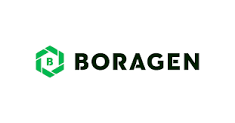
Boron Research from Boragen Sparks Three New Companies

Boron’s value as a plant nutrient is well documented, but it has other properties that make it attractive for crop protection.
Products based on the periodic table’s fifth element may be able to address targets that have eluded traditional chemistry. Also, boron leaves no residue on plants as it decomposes—a key edge over many fungicides and herbicides currently available. Ag bio company Boragen was founded on the promise of boron chemistry, and its research has led to fungicides in field trials and an investor syndicate that includes the Bill & Melinda Gates Foundation.

Research often takes scientists in unanticipated directions. Boragen’s work with boron yielded a separate program in animal health—pets, not production animals. The company also made progress in human health research. Tony Liu, Ph.D., Boragen’s co-founder and chief scientific officer for much of the Research Triangle Park-based startup’s history, said the company’s board of directors and investors saw the opportunities, but they also recognized challenges. Crop protection, animal health, and human health require different strategies and different investors, and they each also have different value drivers.
Liu said the company and its board concluded that the best way for the Boragen platform to find success in all of its potential applications would be by putting each program on its own path. And so Boragen, an ag bio company founded in 2015 focused on protecting plants, is now spawning three different companies.
“It’s really about strategic focus and understanding that this platform is broad,” Liu said. “There are a lot of opportunities but we have to focus in order to execute properly.”
A call sparks a business combination

The animal and human health companies are still in stealth mode, Liu said. The crop protection research of Boragen is now part of a new company called 5Metis. That startup’s formation last summer came down to relationships and timing. At the same time Liu and the Boragen team were pondering the future of their company, another ag bio startup called AgriMetis was also assessing its next steps. Two years ago, BASF acquired the Maryland company’s lead crop protection product, a novel glufosinate herbicide that requires less of the weed killer to be applied to a crop. Following the transaction, AgriMetis still retained some assets. Discussions about what to do with them led Steve Tuttle, the company’s president and CEO, to call Liu. It was not a completely cold call. AgriMetis and Boragen have some investors in common, and those investors thought there might be an opportunity for the two companies to work together.
Boragen had contemplated several options for its crop protection business, Liu said. One was a spinoff that would secure its own funding to continue the crop protection applications started by Boragen. Another option was selling that part of the business to a large ag company. After about two months of discussions, Liu and Tuttle agreed to combine the technologies of their respective companies and form a new startup they called 5Metis. The technologies that comprise 5Metis are complementary. Rather than starting with synthetic chemistry AgriMetis worked with natural products, chemicals made by a living organism, explained Brian Green, the former vice president of research and development at AgriMetis and now chief scientific officer of 5Metis. The challenge of working with such chemicals as they are found in nature is that they are not always suitable for agriculture. AgriMetis did additional chemistry to natural products to make them better suited for agriculture. This is where Boragen’s technology can help. Boron chemistry may be able to make some natural products more stable and more useful for crop applications, Liu said.
The 5Metis name represents the combined technologies that formed the company. Boron is the fifth element; “Metis” comes from AgriMetis and also stands for “molecular evolution through innovative science,” said Tuttle, who is now 5Metis’s president and CEO. The goal of this new company will be to develop crop protection products with new modes of action that overcome the resistance pests are developing to currently available products. Tuttle said 5Metis’s focus on natural products may also address the shift of the industry and regulators toward more environmentally sustainable crop inputs. “When you have a natural products scaffold starting point, you meet some of those criteria,” Tuttle said.
AgriMetis’s capabilities have moved to a new 5Metis laboratory and office in RTP. The 5Metis pipeline will span product candidates that had already reached field trials under Boragen, programs from AgriMetis, and new research programs based on the combination of the Boragen and AgriMetis technologies.
“When you use a chemistry that’s been around for a while, the pests, the weeds you’re trying to target, continue to evolve resistance to that way of killing it or way of controlling it,” Green said. “Natural products have historically been an excellent source of new modes of action. This is a well that has been tapped for many, many years and still has plenty left.”
5Metis’s research is backed by a $10 million Series A round of financing that closed last October. Similar to the model of AgriMetis, Tuttle said he aims to land partnerships with large agricultural companies that will further develop the 5Metis product candidates, register them with regulators, and commercialize them.
Bringing boron chemistry to animals and humans
Boragen signaled the potential of its technology, in both animal and human health, two years ago. The first glimpse was the announcement of a research agreement focused on canine atopic dermatitis. The animal health company partner was not disclosed, nor were any financial terms. That partner, which remains undisclosed and is described by Liu only generally as a multinational company, has an exclusive option to develop and commercialize compounds that stem from the alliance. The new animal health company formed by Boragen will initially focus on inflammation and immunology, Liu said.
Boron’s utility in human health was previously validated by Pfizer’s Eucrisa, a topical ointment for atopic dermatitis that the FDA approved in 2016. Eucrisa is based on boron chemistry that Anacor Pharmaceuticals licensed from Pennsylvania State University; Pfizer acquired Anacor in 2016 in a $5.2 billion deal. Boragen was based on the same Penn State boron technology, but for crop protection applications. Liu said that in the years since the company launched from Penn State’s labs, Boragen has developed its own proprietary technologies for applying boron to plants, animals, and humans. That intellectual property is now split among the three companies formed from Boragen.
Six months after Boragen announced the animal health alliance, the company was awarded a Small Business Innovation Research grant to support application of the company’s boron chemistry to potential antimalarial drugs. According to the grant award, the research builds on a collaboration between the University of California, San Francisco, and Anacor scientists now at Boragen. In its application, Boragen said the research is intended to lead to compounds that show antimalarial activity in the lab, potentially laying the groundwork for further lab and then animal tests.
The new companies formed from Boragen are all separately managed and separately funded, Liu said. The names of the new animal and human health companies remain undisclosed, but Liu said that after they officially launch the Boragen name will be retired. Going forward, Liu will devote his energy to the new human health company. However, he is serving on the scientific advisory board of 5Metis and will also advise the animal health company. The animal health company is completely virtual but has a small office in Tennessee. The human health company will have sites in multiple regions; its North Carolina operations are moving to new office and lab space in RTP. Liu declined to provide details about the new human health company’s therapies or what they would do.
“I think we can say we’re going after oncology,” he said. “I know that’s not very specific. But at this point, that’s all I’m allowed to say.”
